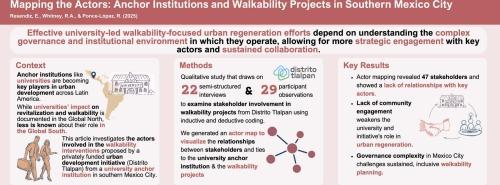Mapping the actors: Anchor institutions and walkability projects in Southern Mexico City
IF 3.1
2区 社会学
Q1 GEOGRAPHY
引用次数: 0
Abstract
Anchor institutions are playing an increasingly prominent role in urban development and revitalization efforts across Latin American cities, including initiatives to enhance walkability. An anchor institution is a large, locally rooted organization (e.g., a hospital, university, etc.) whose long-term sustainability is tied to the wellbeing of the community it serves, playing a significant role in shaping that community’s development. While the role of anchor institutions in urban revitalization has been well-documented in the global North, their influence in the global South, including in walkability projects, remains understudied. This article investigates the actors involved in the walkability interventions proposed by a privately funded urban regeneration initiative from a university anchor institution in southern Mexico City. Drawing on 22 semi-structured interviews and 29 participant observations, 47 actors were identified as being involved with the development and implementation of walkability projects, of which 18 had direct or indirect relationships via the anchor institution. Our findings suggest that the lack of relationships and communication with key stakeholders fosters a disconnect between the lead anchor institution and its ability to coordinate walkability interventions over the long term. We conclude by discussing how the complexity of actor relationships influences walkability efforts, alongside the evolving role of anchor institutions in urban planning and development in Latin America.

绘制参与者:墨西哥城南部的锚定机构和步行项目
锚定机构在拉丁美洲各城市的城市发展和振兴工作中发挥着越来越重要的作用,包括提高步行性的举措。锚定机构是扎根于当地的大型组织(如医院、大学等),其长期可持续性与其所服务社区的福祉息息相关,在塑造该社区的发展方面发挥着重要作用。虽然锚定机构在城市振兴方面的作用在发达国家已得到充分证明,但它们在发展中国家的影响,包括在可步行性项目方面的影响,仍未得到充分研究。本文调查了墨西哥城南部一所大学的一项由私人资助的城市再生计划所提出的可步行性干预措施的参与者。根据22个半结构化访谈和29个参与者观察,确定了47个参与者参与了可步行性项目的开发和实施,其中18个参与者通过锚定机构有直接或间接的关系。我们的研究结果表明,缺乏与主要利益相关者的关系和沟通,导致了主要锚定机构与其长期协调步行性干预措施的能力之间的脱节。最后,我们讨论了行动者关系的复杂性如何影响步行性的努力,以及锚定机构在拉丁美洲城市规划和发展中的作用。
本文章由计算机程序翻译,如有差异,请以英文原文为准。
求助全文
约1分钟内获得全文
求助全文
来源期刊

Geoforum
GEOGRAPHY-
CiteScore
7.30
自引率
5.70%
发文量
201
期刊介绍:
Geoforum is an international, inter-disciplinary journal, global in outlook, and integrative in approach. The broad focus of Geoforum is the organisation of economic, political, social and environmental systems through space and over time. Areas of study range from the analysis of the global political economy and environment, through national systems of regulation and governance, to urban and regional development, local economic and urban planning and resources management. The journal also includes a Critical Review section which features critical assessments of research in all the above areas.
 求助内容:
求助内容: 应助结果提醒方式:
应助结果提醒方式:


